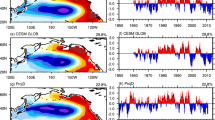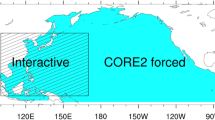Abstract
During El Niño events when positive sea surface temperature (SST) anomalies form in the equatorial Pacific, SST anomalies also tend to develop in the North Pacific. This study attempts to model and explain the large-scale features of the observed SST anomaly field in the North Pacific during the fall and winter of the El Niño year. The experiment design consists of a mixed layer ocean model of the North Pacific which is forced by atmospheric surface fields from two sets of Community Climate Model (CCM) integrations: the El Niño set with prescribed positive SST anomalies in the tropical Pacific; and the control set which is obtained from an extended CCM integration with prescribed climatological SSTs. The response of the midlatitude ocean to atmospheric surface fields associated with El Niño is obtained by compositing each set of model integrations (El Niño and Control) and then taking the difference between the composites. The ocean model is able to reproduce the general features of the observed midlatitude SST anomaly pattern: warm water in the northeast Pacific and an elliptically shaped cold pool in the central Pacific. In these regions, a large fraction of the temperature anomalies are significant at the 95% level as indicated by a two tailed t-test. The ocean temperature anomalies simulated by the model are primarily caused by changes in the sensible and latent heat flux and to a lesser extent the longwave radiation flux. Entrainment of cold water from below the mixed layer also influences ocean temperatures. However, the entrainment anomaly pattern has a complex spatial structure which does not always coincide with the simulated mixed layer temperature anomalies.
Similar content being viewed by others
References
Aragão JOR (1986) A general circulation model investigation of the atmospheric response to El Niño. Cooperative Thesis No 100, University of Miami and National Center for Atmospheric Research, pp 144
Bathen KH (1972) On the seasonal changes in the depth of the mixed layer in the North Pacific Ocean. J Geophys Res 77:7138–7150
Bjerknes J (1966) A possible response of the atmospheric Hadley circulation to equatorial anomalies of ocean temperatures. Tellus 18:820–829
Bjerknes J (1969) Atmospheric teleconnections from the equatorial Pacific. Mon Wea Rev 97:163–172
Blackmon ML, Geisler JE, Pitcher EJ (1983) A general circulation model study of January climate anomaly patterns associated with interannual variation of equatorial Pacific sea surface temperatures. J Atmos Sci 40:1410–1425
Camp NT, Elsberry RL (1978) Oceanic thermal response to strong atmospheric forcing, II. The role of one-dimensional processes. J Phys Oceanogr 8:215–224
Chervin RM (1986) Interannual variability and seasonal climate predictability. J Atmos Sci 43:233–251
Chervin RM, Schneider SH (1976) On determining the statistical significance of climate experiments with general circulation models. J Atmos Sci 33:405–412
Clark NE (1972) Specification of sea surface temperature anomaly patterns in the eastern North Pacific. J Phys Oceanogr 2:391–404
Davis RE (1976) Predictability of sea surface temperature and sea level pressure anomalies over the North Pacific Ocean. J Phys Oceanogr 6:249–266
Davis RE, DeSzoeke R, Nüler P (1981) Variability in the upper ocean during MILE. Part 11: Modeling the mixed layer response. Deep-Sea Res 28A:1453–1475
Emery WJ, Hamilton K (1985) Atmospheric forcing of interannual variability in the northeast Pacific Ocean: connections with El Niño. J Geophys Res 90:857–868
Emery WJ, Lee WG, Mygaard L (1984) Geographic and seasonal distribution of Brunt-Väisäld frequency and Rossby radii in the North Pacific and North Atlantic. J Phys Oceanogr 14:294–317
Enfield DB, Allen JS (1980) On the structure and dynamics of monthly mean sea level anomalies along the Pacific coast of North and South America. J Phys Oceanogr 10:557–578
Favorite F, McLain DR (1973) Coherence in transpacific movements of positive and negative anomalies of sea surface temperature, 1953–1960. Nature 244:139–143
Frankignoul C (1985) Sea surface temperature anomalies, planetary waves and air-sea feedback in the middle latitudes. Rev Geophys 23:357–390
Frankignoul C, Reynolds RW (1983) Testing a dynamical model for midlatitude sea surface temperature anomalies. J Phys Oceanogr 13:1131–1145
Gill AE, Turner JS (1976) A comparison of seasonal thermocline models with observations. Deep-Sea Res 23:391–401
Haney RL, Houtman BH, Little WH (1983) The relationship between wind and sea surface temperature anomalies in the midlatitude North Pacific Ocean. Atmosphere-Ocean 21:168–186
Heald RC, Kim J-W (1979) Parameterization of the oceanic mixed layer for use in general circulation models. Department of Atmospheric Science and Climatic Research Institute, Oregon State University, Corvalis, Report No 10, 48pp
Horel JD, Wallace JM (1981) Planetary-scale atmospheric phenomena associated with the Southern Oscillation. Mon Wea Rev 109:813–829
Hoskins BJ, Karoly DJ (1981) The steady linear response of a spherical atmosphere to thermal and orographic forcing. J Atmos Sci 38:1179–1196
Le Treut H, Simonot JY, Crepon M (1985) A model for the seasurface temperature and heat content in the North Atlantic Ocean. Nihoul JCJ (ed) Coupled ocean-atmosphere models. Elsevier Oceanographic Series 40:439–446
Luksch U, Storch Hv, Maier-Reimer E (1989) Modeling North Pacific SST anomalies as a response to anomalous atmospheric forcing. Max Planck-Institut für Meteorologie, Hamburg, Report No 37, 31 pp
McCreary JP Jr (1976) Eastern tropical ocean response to changing wind systems: with application to El Niñio. J Phys Oceanogr 6:632–645
Miyakoda K, Rosati A (1984) The variation of sea surface temperature in 1976 and 1977, 2. The simulation with mixed layer models. J Geophys Res 89:6533–6542
Mysak LA (1986) El Niño, interannual variability and fisheries in the northeast Pacific Ocean. Can J Fish Aquat Sci 43:464–497
Namais J (1959) Recent seasonal interactions between North Pacific waters and the overlying atmospheric circulation. J Geophys Res 64:631–646
Namais J (1965) Macroscopic association between between mean monthly sea surface temperature and the overlying winds. J Geophys Res 70:2307–2318
Namais J (1969) Seasonal interactions between the North Pacific Ocean and the atmosphere during the 1960's. Mon Wea Rev 97:173–192
Nüler PP, Kraus EB (1977) In: One-dimensional models of the upper ocean. Kraus EB (ed), Modeling and prediction of the upper layers of the ocean. Pergamon Press, Oxford, pp 143–172
Palmer TN, Sun Z (1985) A modelling and observational study of the relationship between sea surface temperature in the northwest Atlantic and the atmospheric general circulation. Quart J R Met Soc: 111:947–975
Pan YH, Oort AH (1983) Global climate variations connected with sea surface temperature anomalies in the eastern equatorial Pacific Ocean for the 1958–73 period. Mon Wea Rev 111:1244–1258
Philander GS (1990) El Niño, La Niña, and the Southern Oscillation. Academic Press, Inc, San Diego New York Berkely Boston London Sydney Tokyo Toronto, 293 pp
Pitcher EJ, Blackmon ML, Bates GT, Muñoz S (1988) The effects of North Pacific sea surface temperature anomalies on the January climate of a general circulation model. J Atmos Sci 45:173–188
Pitcher EJ, Malone RC, Ramanathan V, Blackmon ML, Puri K, Bourke W (1983) January and July simulations with a spectral general circulation model. J Atmos Sci 40:580–604
Rasmusson EM, Carpenter TH (1982) Variations in tropical sea surface temperature and surface wind fields associated with the Southern Oscillation/El Niño. Mon Wea Rev 110:354–384
Reynolds RW, Rasmusson EM (1983) The North Pacific sea surface temperature associated with El Niño. Proceedings of the Seventh Annual Climate Diagnostic Workshop, Boulder, CO, October 18–22, 1982. NOAA, Washington, DC, pp 298–310. [NTIS No PB83–208033]
Rienecker MM, Mooers CNK (1986) The 1982–1983 El Niño signal off northern California. J Geophys Res 91:6597–6608
Sausen R, Barthel K, Hasselmann K (1988) Coupled ocean-atmosphere models with flux correction. Climate Dynamics 2:145–163
Semtner AJ (1984) Development of efficient, dynamical ocean-atmosphere models for climatic studies. J Climate Appl Meteor 23:353–374
Simpson JJ (1983) Large scale thermal anomalies in the California current during the 1982–83 El Niño. Geophys Res Lett 10:937–940
Wagner AJ (1984) Possible mid-latitude atmospheric, generation of anomalously warm surface waters in the Gulf of Alaska from autumn 1982 to spring 1983. Trop Ocean-Atmos Newslett 26:15–16
Wallace JM, Jiang Q-R (1987) On the observed structure of the interannual variability of the atmosphere/ocean climate system. Cattle H (ed), Atmospheric and oceanic variability. R Meteor Soc, Bracknell, Berkshire, pp 17–43
Washington WM (ed) (1982) Documentation for the Community Climate Model (CCM), version 0. National Center for Atmospheric Research, Boulder, Colorado [NTIS No. PB82–194192]
Weare BC, Navato AR, Newell RE (1976) Empiracle orthogonal analysis of Pacific Ocean sea surface temperatures. J Phys Oceanogr 6:671–678
Webster PJ (1981) Mechanisms determining the atmospheric response to sea-surface temperature anomalies. J Atmos Sci 38:554–571
Author information
Authors and Affiliations
Rights and permissions
About this article
Cite this article
Alexander, M.A. Simulation of the response of the North Pacific Ocean to the anomalous atmospheric circulation associated with El Niño. Climate Dynamics 5, 53–65 (1990). https://doi.org/10.1007/BF00195853
Received:
Accepted:
Issue Date:
DOI: https://doi.org/10.1007/BF00195853




